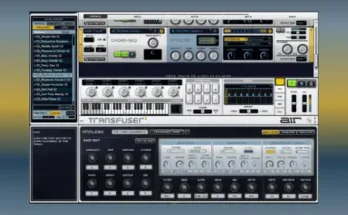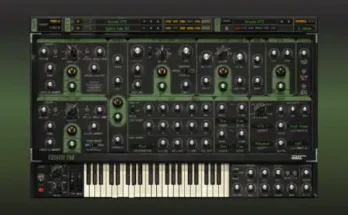Pre 1973 v1.6.0 Mac
MORiA | December, 13 | AU | VST | VST3 | AAX | 264 MB
The subtle nuance and tonal flavor added by a vintage preamp can have an amazing overall effect on the music you create.
For years, top producers have coveted the sound of the venerable 1073 preamp. Now – through the power of Arturia’s advanced TAE modelling – you too can have a taste of that harmonically rich, classic tone in your DAW.
Devised by visionary electronics engineer and pro audio legend Rupert Neve, the preamp became a staple of the world’s top studios, and added its unique tonal flavor to countless hits. It was a revolution in 1970, pioneering the use of reliable high-efficiency transistors to replace the temperamental vacuum tube technology of the time. The sound of the preamp became an instant hit with record producers, sound engineers, and artists the world over, cementing its place in music history.
Continuing that revolution, using their exclusive TAE technology, Arturia have recreated this phenomenal piece of music production history. Capturing and recreating its distinct musical color, its pleasing analog distortion, and its sweet-sounding tone controls, you’ll be able to start your virtual signal chain with one of the best sounding pres ever created.
Analog sound in the digital world
… but my audio interface already has preamps. Why do I need virtual preamps? What difference will it make?
Great question!
As you’ll know, preamps raise the gain of incoming signals – from microphones and musical instruments – to usable levels, which can then be mixed. Practically all modern audio interfaces include preamps, just as most analog mixing consoles integrated preamps in the pre-digital age.
Thanks to today’s technology, preamps are very neutral and transparent in the way they amplify the audio signal. In the past, preamps tended to subtly distort the sound, imparting a tonal character to the audio they processed; a sort of “sonic fingerprint” that music producers would become familiar with, and start to use in creative ways. This is what people usually refer to when they talk about ‘the sound’ of a mixing console. Running a session on a mixing console that used the 1073 preamps, for example, would give the whole track a harmonically exciting feel.
Now, you can enjoy the best of both worlds. You can use the preamps on your audio interface to get your signals to a usable level, and use Arturia’s software preamps to impart that iconic tone to your tracks.
Adding that “je ne sais quoi”
It’s difficult to let new producers and mix engineers know just how important the subtle sound-shaping power of preamps are; we’re talking about something understated. It’s not a flashy synth or an extreme audio-mangling plug-in.
At their core, all of our preamp plugins provide 2 main benefits:
A link to the past
There’s something quite magical about hearing classic songs. If you let your mind drift, you’re transported to a totally different time: different fashion, different politics, different tastes, different lives. If you want to evoke the feeling of the 70s or 80s, when the 1073 was used on practically every chart hit, our 1973-Pre makes it easy. Added to individual tracks in your song, you can add that toasty, harmonic, saturated sound that typified the era.
Mixing confidence
Load up 1973-Pre as an “insert” effect on channel, dial in an appropriate preset, and most of the hard work has been taken care of. You’ll now be mixing with the sound of a classic analog console, with the parameters set up by a top sound designer. Now you’re free to get creative, safe in the knowledge that you have half a century of legendary pro audio heritage supporting you.
Rediscover an industry legend
Beautifully simple, yet stunningly effective, the 1973-Pre offers simple controls that pros will feel right at home with, and newcomers will quickly learn to love.
3-band equalizer
Creatively shape your signal with low, medium, and high band controls of +/- 18dB. The low band lets you perfectly balance the bass content in your signal, the mid band can add presence or cut the mud, and the high band can add shine and air, or remove any unwanted sharpness.
Input gain
Controls how much of your signal is sent through the circuitry. Subtle levels will introduce that flattering brilliance that the 1073 is known for. Pushing harder will introduce harmonic distortion, adding presence and fatness.
High pass filter
Cuts the super-low end, inaudible rumble in your signal. Switched on, this can give your mix more headroom and energy. Left off, it lets through the bass you feel, rather than hear.
Output trim
A fully transparent volume control to give your DAW exactly the level of signal you want.
Release Notes – 1.1.0.388
New Features:
NKS compatibility
Control knob with mouse scroll
Added maximize height button
Minor browser improvements
Bugfixes FX Collection:
No more crash on old CPUs
No more crash when removing the plugin from a track in FL Studio 20 on macOs
Favorites are now recalled correctly
Cubase bypass function now works properly
Faders and encoders now stop moving after your release them in Reason
No more delay when moving a linked parameter
VU meter calibration is now properly recalled in DAWs
No more issue when automating toggle parameters in AAX
Simpler crack = faster loading time compared to Hexwars release
Release notes:
June, 9 2022 | v1.6.0New features:
A/B comparison function with independent history
SDK update: new preset browser, toolbars and menus design ; new FX iconsImprovements:
DSP preamp optimization
Faster project opening time
Faster preset loading timeBug fixes:
Fixed crash in MacOS BigSur case sensitive
Please REPORT in Comment Broken Links




